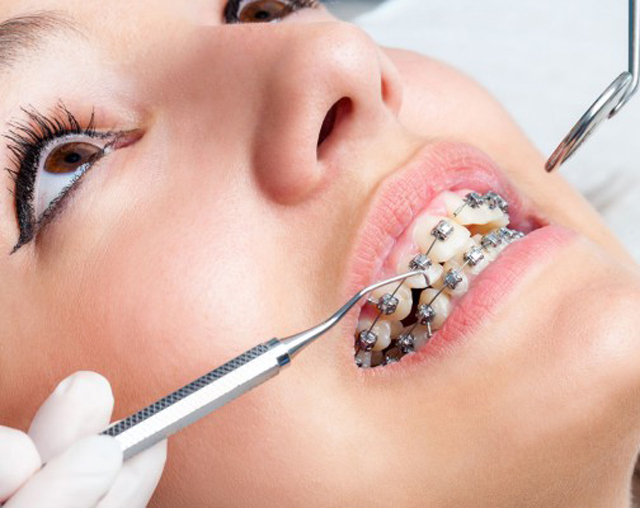The process of putting on braces is nerve-wracking to many. The thought of the experience triggers anxiety. For beginners, this raises many questions like how long the process takes and how it is painful. The process only takes 1–2 hours approximately. This varies depending on the teeth and the type of braces. The process is not painful but can cause soreness and discomfort due to pressure. The first step is to set up the first appointment with the orthodontist. During this visit, the dentist will examine the teeth, ask a few questions, and may need to take some X-rays. From their findings, they will prescribe the mode of treatment which may take off immediately. The process of putting on braces varies depending on the type of braces.

Conventional metal/ceramic braces
Preparation
For those whose back teeth are close together, the orthodontist places rubber bands or spacers between them for a week before bracing. This is to create adequate space for the bands to fit around the back teeth. The disadvantage of this is that it causes soreness on the back teeth & jaw when the teeth move to create space for the spacers.
Cleaning
Before the process of putting on braces, the Orthodontist will clean the teeth with a cleaning paste, then ensure they are dried.
Attaching the brackets
Brackets are tiny metals/ ceramic materials that hold the wires in position on the teeth.
Glue /bonding cement is then applied to the center of every tooth. The dentist will then shine a blue light on the teeth to set the glue. Finally, place the bracket on the center of the tooth. The glue is distasteful but not harmful.
Placing the bands
To hold the brackets, metallic bands are put on the back molars. The band should be of the right size to fit the tooth. Orthodontist applies glue on the band. The blue light sets the glue, and the band placed on the molars. This placement can have a twitching feeling. If so, inform the orthodontist to adjust and make it comfortable.
Addition of archwires
When the brackets and bands are in place, the orthodontist connects the archwire to the brackets. To achieve this, wound a small rubber band around each bracket to attach the wire in position. For the rubber bands, you can choose the color of your choice. The final step is cutting the archwire’s ends to prevent it from touching the gums or the back of the mouth.
Invisible braces
This process of putting on braces is different from the rest as it does not require bands or wires. The orthodontist will make a mold to form an impression on your teeth on the first visit, to ensure that the trays fit perfectly. On the first day of treatment, you have to try on the alignment tray and make the required adjustments. The orthodontist will then teach you how to wear and care for the tray and teeth during the process.
Lingual braces
They have an almost similar process to conventional metal. The only difference is that it’s applied at the backside of the teeth or the tongue side close to the mouth. Since it’s a bit complex, the process takes a little longer than conventional braces, and only a trained Orthodontist should do this bracing.

Other attachments
When placing the alignment tray, it is important to note that some teeth require special attention because if their positioning. To ensure that all teeth will move to their rightful positions, the orthodontist will stick some tiny attachments similar to the tooth color. They may also attach tiny tooth-colored mounds close to the back of the mouth. This meant connecting the upper and lower part with small rubber bands. This also helps the teeth move into position.
Regular appointments
After 1 or 2 weeks, schedule an orthodontist appointment to check on progress and get new trays. New trays like metal braces make the teeth and its surrounding mouth region sore for days.
The after feeling
The whole process will cause a feeling of discomfort in the mouth. It’s only when you eat that you’ll experience pain. In the first few days, you can only eat soft foods like smoothies, yogurt, soft vegetables, mashed potatoes, and others. Some people may experience headaches for some days. In this case, you can get over the counter pain killers or oral anesthetic to ease the pain. It might also cause soreness where the brackets or wires touch the inside cheek. You can use wax provided by the orthodontist to cover the areas on the braces causing soreness. You can also use salty water to rinse your mouth or apply topic anesthetic to the affected parts. After a month, the mouth will have adjusted to the new additions, and soreness will no longer be a problem.
Dental care after bracing
Putting on braces comes with extra dental care. The orthodontist will guide you through a new way of brushing and flossing to avoid stains and cavities on teeth. It would help if you brushed your teeth several times a day, even when away from home. After eating or drinking anything sugary, swish water to get rid of the particles left behind. Tools like water flosser or an interproximal brush get underneath the archwire to clean the teeth. After some time, the teeth will start aligning itself as expected.
Schedule an Appointment
Error: Contact form not found.

